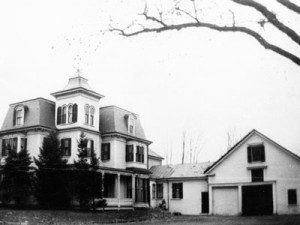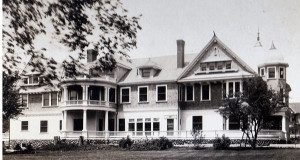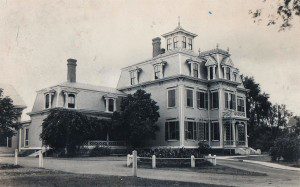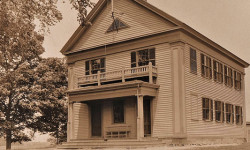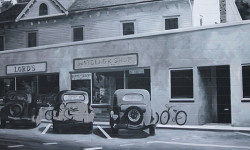[ccfic caption-text format="plaintext"]
The photos show nine pieces of Medfield’s history, nine historic houses and structures, that have unfortunately been demolished by the backhoe, bulldozer and even by a tank, and lost forever. The tenth photo shows the Clark Tavern, which is about to join this devastating list of perhaps the ten greatest losses of town history; this time, the demolition will be by neglect. A key factor of what makes Medfield, Medfield is its history, its historic look, its historic houses; sadly, board by board, we are losing that very fabric. Unless we do something soon, another piece will be lost forever.
The Clark Tavern, itself, is actually two houses attached to one another. The westerly end of the house, being known as the old Clark Tavern, was built about 1740 by Seth Clark and kept as a tavern and inn by Seth and his son, Ebenezer. Seth was the most influential of the Clarks. It was he who added to the front of the house, extending its size. Seth served as town selectmen, representative to the General Court, delegate to the Provincial Congress and assistant commissary in the Continental Army during the Revolutionary War. In 1773, son Ebenezer had the easterly end built, attached to the original tavern. The Clark Tavern and Inn became a popular meeting place for the town. Selectmen went there after their meetings. Townspeople gathered there to discuss the latest outrage from the British government.

1867, Daniel D. Curtis House, 50 North Street, corner of North and Frairy Streets, opposite Meetinghouse Pond: demolished.
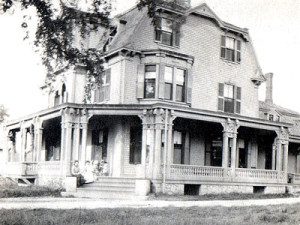
1875, John Jay Adams/Pfaff Mansion, 121 North Street, opposite Dale Street (now site of apartments): demolished.
It was a stagecoach stop on the Hartford-Boston Turnpike, also known as the Middle Road, going from Boston down to New York City. Many a weary traveler stayed overnight before continuing the long stagecoach trip. Nathan Hale of history book fame, who was sent by General George Washington to spy on the British in NYC before being captured and hanged, stayed in the Clark Tavern. Hale’s immortal words, “I regret that I have but one life to give for my country,” are an important part of our nation’s history.
During the occupation of Boston, minutemen from Connecticut were sent up as far as Medfield to guard the turnpike in the event the British tried to break out of Boston and head for New York City. The Connecticut militia used the Clark Tavern as their headquarters. The post office was kept there from 1809-1818. Around 1810, the hall at the rear of the house was built by Ebenezer Junior, son of Ebenezer. The hall was used by numerous groups over the years, including the Sons of Temperance; dances were held there and enjoyed by the families in town. It was called the “most beautiful hall in the region.” At its dedication, people came from surrounding towns to take part in the festivities. Catholics held their services there before the building of St. Edward Church. A wedding was also performed in the hall.
The westerly end was purchased by Warren Hartshorn in 1814, whose grandson married into the Adams family. The Adams lived there for many years. In 1912, Bessie Adams married Fred Laverty. The tavern stayed in the Laverty family until its sale in 2007 to Stephen and Lynn Browne. The Tavern ownership then passed from the Brownes to John and Michelle Linnert.
In a win-win situation for the town, the Linnerts were planning to preserve and restore the historic landmark at their own expense and open a Sherborn Inn style tavern, originally with a couple of B&B rooms. Under their plan, the tavern would have retained its historical self. They hired a well-respected historical architect to work on the project. Beams, molding, and as much of the interior as is possible was to remain intact. They went out of their way to make sure the outside/streetscape of the Tavern was to remain untouched, but restored. For anyone driving by, the tavern would have looked look like it did 200 years ago. Medfield Zoning and Planning Board approved their plan. But then, three neighbors of the Tavern took the Town of Medfield and the Linnerts to Land Court, which dragged on for years. Finally, the Linnerts, feeling they had no other choice, entered into an agreement with LCB, which was proposing to build assisted living units behind the Tavern and Peak House. The LCB project is also now held up in court and as a result, so is the fate of the Tavern.
Historic houses make up much of our character as a community, especially along East Main Street, the gateway into the town. We have been generally lucky to date that so many historically-minded people have bought many of Medfield’s historic homes. To their credit, they have cared for and restored these houses. The town is greatly in debt to them, as the character of the historic houses impacts the character of the town as a whole and impacts everyone’s property values.
But neither the Clark Tavern, nor East Main Street, for that matter, are in a historic district. We are vulnerable to losing our history and character with the demolition of any of those historic homes, which could potentially be replaced by 40B projects or high-density housing, like the project proposed by LCB. Medfield has also not approved the Community Preservation Act, which could be used to preserve historic houses and save our town’s history.
The Clark Tavern is an excellent example of an early Colonial structure and one of the oldest houses in Medfield. Its Colonial and Revolutionary War history extends its importance far beyond the borders of Medfield. Its architectural form, age, and well-preserved setting are all important elements of its significance to our community.
It is also facing demolition by neglect.
Unless the selectmen and town citizens act soon to do something - anything - it will be gone forever.







